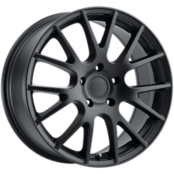Also referred to as wheel width, the width of your rims is measured from bead seat to bead seat, as indicated in the image above. That's because this is the point of contact between your tires and wheels.
Luckily, measuring rim width is pretty simple to do! Just take a ruler, yardstick or tape measure and measure the distance from bead seat to bead seat. The rim width is also included in the wheel size, which you can find stamped on the back of the wheel, or in your owner's manual.
As with all things fitment, it's critical to make sure your tires and wheels are the right size. For your safety and the optimal ride, your rim width and tire size must be compatible. Why? Because the rim width has a direct impact on your tire's contact patch, which changes how the tire interacts with the road and how your vehicle handles.
That's why rim width plays a key role when replacing rims or modifying your tire size.
What's the Max Tire Size for Rim Width?
When replacing your wheels, keep in mind that tires have their own widths that must be compatible with your rims. Thanks to the flexible construction, most tire sizes will work on a small range of rim widths.
That said, it's important to stay within the range of approved rim width/tire size combinations, which are determined by the Tire and Rim Association, as well as the European Tire and Rim Technical Organization.
For example, a 245/45R20 has a rim width range of 7.5" to 9.5". This means that this tire size would fit the following rim sizes:
While it may be possible to mount a tire on a rim width that falls outside its range of approved fitments, doing so can lead to irregular treadwear, poor vehicle performance and even tire failure. We’ll only mount tires on rims within the recommended width.
HOW DOES RIM WIDTH CHANGE PERFORMANCE?
Another reason rim width is so important is because it has a direct impact on how your vehicle performs.
Here’s how: if you increase your rim width while keeping the same size tire, the extra width makes the tire slightly wider and tightens up the sidewall. That reduction of flexibility in the sidewall of the tire ensures faster steering response.
Keep in mind, with a stiffer sidewall, the tire won’t absorb impacts as well. That means your ride might be a little less comfortable on your new, wider wheels.
Similarly, if you decrease the width of your rim without changing the overall tire size, the tire sidewall will be slightly narrower and will become more flexible. While this will soften up handling, it should also provide a slightly smoother ride.


Need new rubber to wrap around your flashy new rims? After all, a custom tire and wheel package is the best way to amp up your ride's aesthetic and performance with a single upgrade.
Plus, you're in the right spot to upgrade and save! We've got the largest inventory of aftermarket tires, not to mention the lowest prices in the industry.
When you're ready for your wheel upgrade, we can get you taken care of. Stop by any of our America's Tire locations and we'll get you taken care of! Customers who buy and book online save time in-store!

